Gatsby Grange Boutique Hotels: Financial Ratio Analysis and Evaluation
VerifiedAdded on 2023/01/10
|10
|2569
|73
Report
AI Summary
This report presents a financial ratio analysis of Gatsby Grange, a small UK-based boutique hotel chain, for the period of 2018 to 2019. It begins with an introduction to financial statement evaluation and the importance of ratio analysis in assessing a company's health. The main body of the report ...
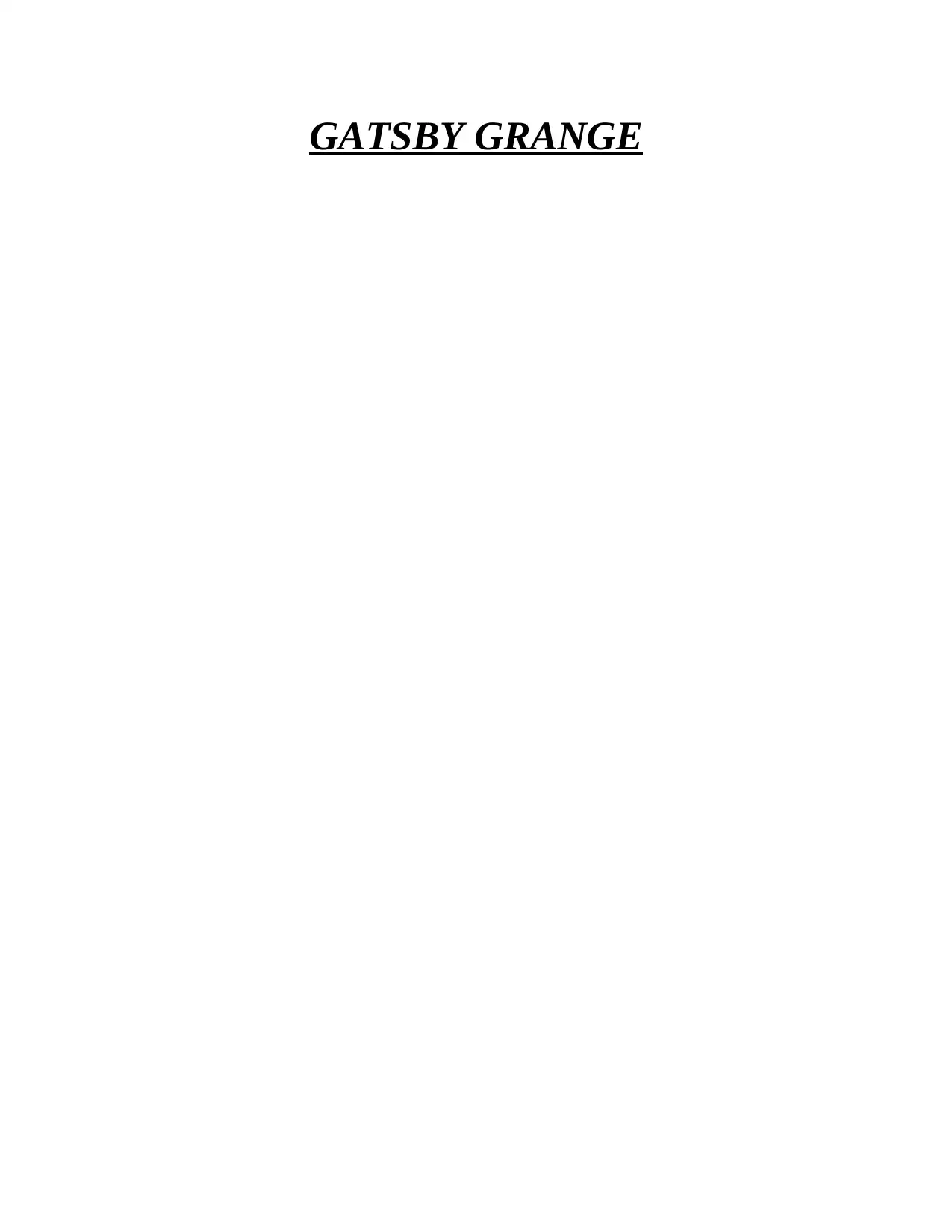
GATSBY GRANGE
Paraphrase This Document
Need a fresh take? Get an instant paraphrase of this document with our AI Paraphraser
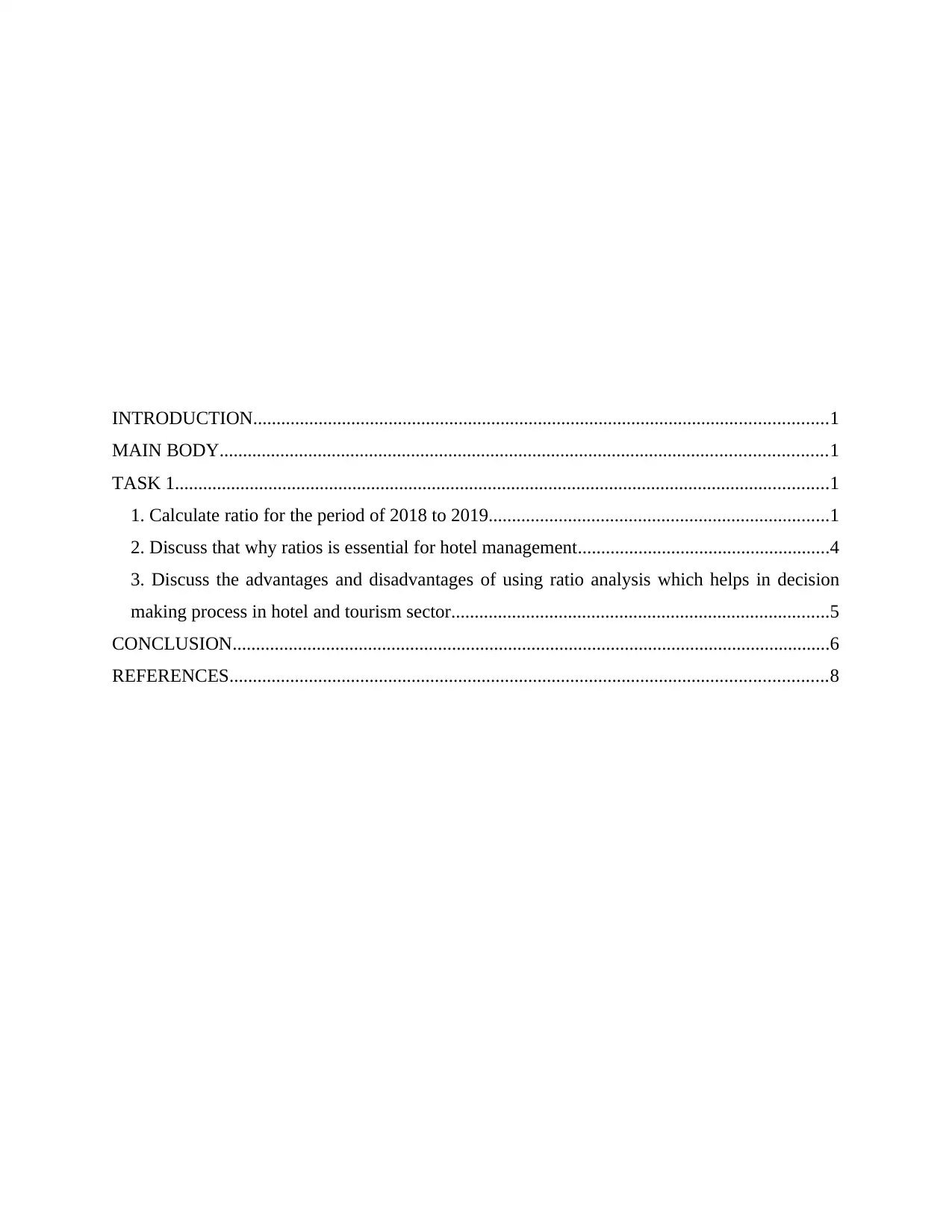
INTRODUCTION...........................................................................................................................1
MAIN BODY..................................................................................................................................1
TASK 1............................................................................................................................................1
1. Calculate ratio for the period of 2018 to 2019.........................................................................1
2. Discuss that why ratios is essential for hotel management......................................................4
3. Discuss the advantages and disadvantages of using ratio analysis which helps in decision
making process in hotel and tourism sector.................................................................................5
CONCLUSION................................................................................................................................6
REFERENCES................................................................................................................................8
MAIN BODY..................................................................................................................................1
TASK 1............................................................................................................................................1
1. Calculate ratio for the period of 2018 to 2019.........................................................................1
2. Discuss that why ratios is essential for hotel management......................................................4
3. Discuss the advantages and disadvantages of using ratio analysis which helps in decision
making process in hotel and tourism sector.................................................................................5
CONCLUSION................................................................................................................................6
REFERENCES................................................................................................................................8
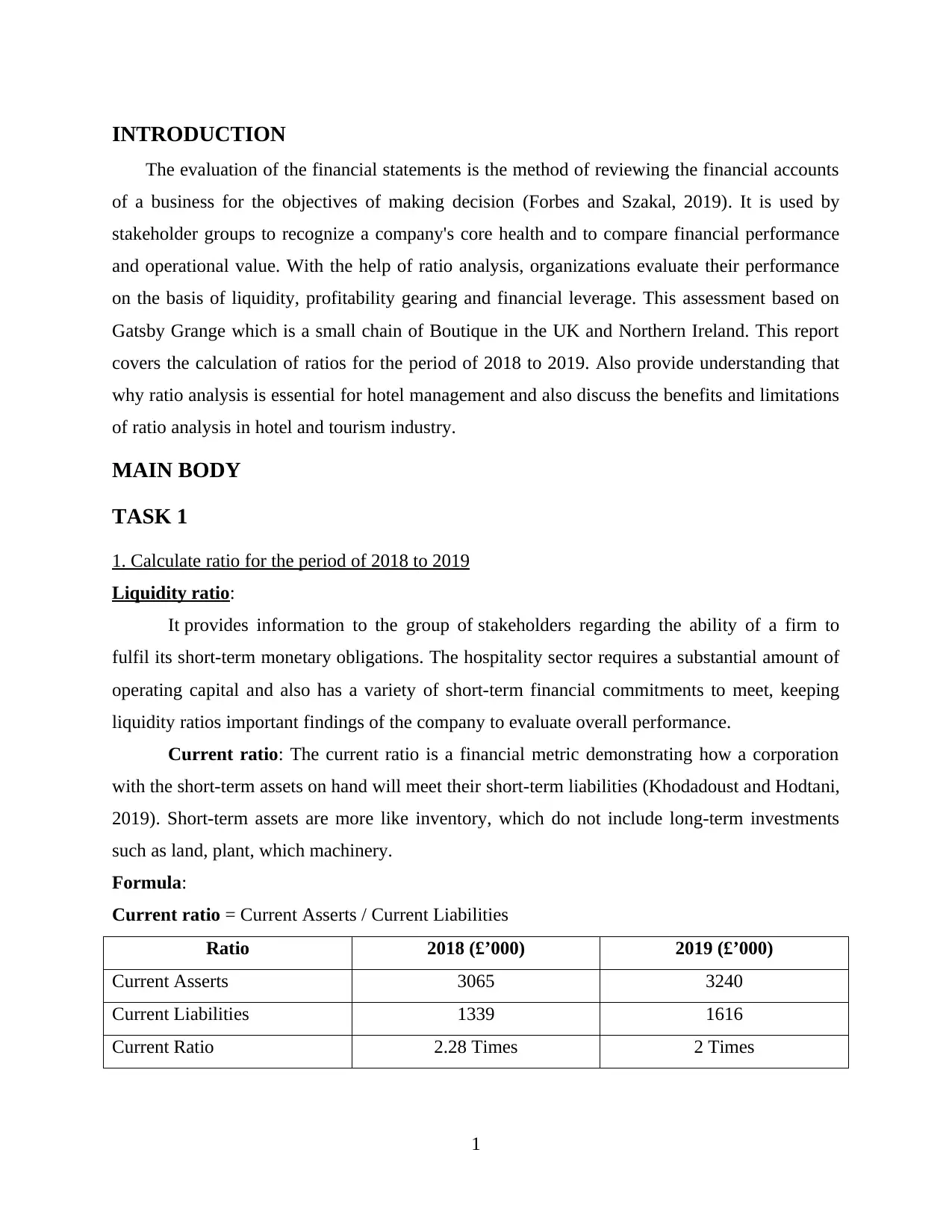
INTRODUCTION
The evaluation of the financial statements is the method of reviewing the financial accounts
of a business for the objectives of making decision (Forbes and Szakal, 2019). It is used by
stakeholder groups to recognize a company's core health and to compare financial performance
and operational value. With the help of ratio analysis, organizations evaluate their performance
on the basis of liquidity, profitability gearing and financial leverage. This assessment based on
Gatsby Grange which is a small chain of Boutique in the UK and Northern Ireland. This report
covers the calculation of ratios for the period of 2018 to 2019. Also provide understanding that
why ratio analysis is essential for hotel management and also discuss the benefits and limitations
of ratio analysis in hotel and tourism industry.
MAIN BODY
TASK 1
1. Calculate ratio for the period of 2018 to 2019
Liquidity ratio:
It provides information to the group of stakeholders regarding the ability of a firm to
fulfil its short-term monetary obligations. The hospitality sector requires a substantial amount of
operating capital and also has a variety of short-term financial commitments to meet, keeping
liquidity ratios important findings of the company to evaluate overall performance.
Current ratio: The current ratio is a financial metric demonstrating how a corporation
with the short-term assets on hand will meet their short-term liabilities (Khodadoust and Hodtani,
2019). Short-term assets are more like inventory, which do not include long-term investments
such as land, plant, which machinery.
Formula:
Current ratio = Current Asserts / Current Liabilities
Ratio 2018 (£’000) 2019 (£’000)
Current Asserts 3065 3240
Current Liabilities 1339 1616
Current Ratio 2.28 Times 2 Times
1
The evaluation of the financial statements is the method of reviewing the financial accounts
of a business for the objectives of making decision (Forbes and Szakal, 2019). It is used by
stakeholder groups to recognize a company's core health and to compare financial performance
and operational value. With the help of ratio analysis, organizations evaluate their performance
on the basis of liquidity, profitability gearing and financial leverage. This assessment based on
Gatsby Grange which is a small chain of Boutique in the UK and Northern Ireland. This report
covers the calculation of ratios for the period of 2018 to 2019. Also provide understanding that
why ratio analysis is essential for hotel management and also discuss the benefits and limitations
of ratio analysis in hotel and tourism industry.
MAIN BODY
TASK 1
1. Calculate ratio for the period of 2018 to 2019
Liquidity ratio:
It provides information to the group of stakeholders regarding the ability of a firm to
fulfil its short-term monetary obligations. The hospitality sector requires a substantial amount of
operating capital and also has a variety of short-term financial commitments to meet, keeping
liquidity ratios important findings of the company to evaluate overall performance.
Current ratio: The current ratio is a financial metric demonstrating how a corporation
with the short-term assets on hand will meet their short-term liabilities (Khodadoust and Hodtani,
2019). Short-term assets are more like inventory, which do not include long-term investments
such as land, plant, which machinery.
Formula:
Current ratio = Current Asserts / Current Liabilities
Ratio 2018 (£’000) 2019 (£’000)
Current Asserts 3065 3240
Current Liabilities 1339 1616
Current Ratio 2.28 Times 2 Times
1
⊘ This is a preview!⊘
Do you want full access?
Subscribe today to unlock all pages.

Trusted by 1+ million students worldwide
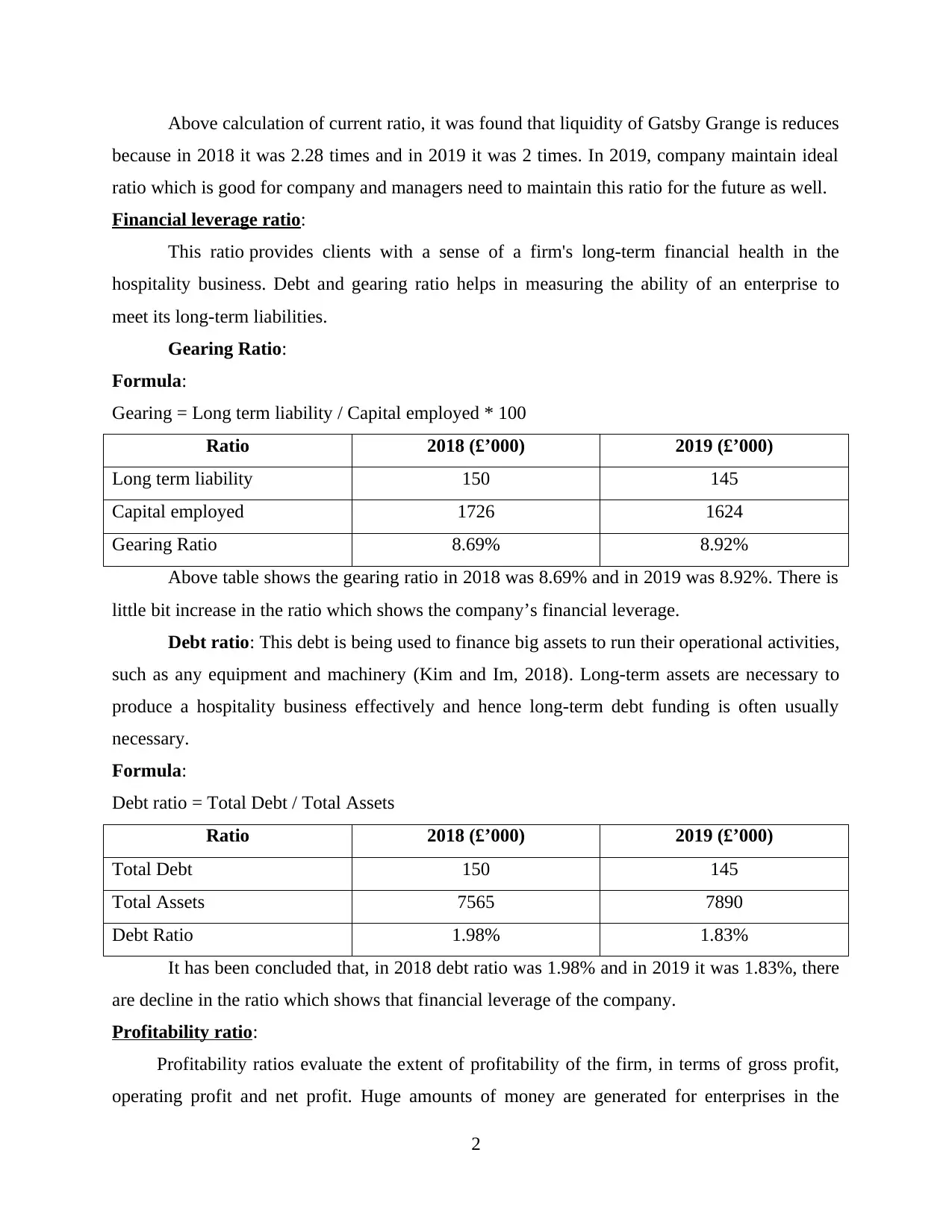
Above calculation of current ratio, it was found that liquidity of Gatsby Grange is reduces
because in 2018 it was 2.28 times and in 2019 it was 2 times. In 2019, company maintain ideal
ratio which is good for company and managers need to maintain this ratio for the future as well.
Financial leverage ratio:
This ratio provides clients with a sense of a firm's long-term financial health in the
hospitality business. Debt and gearing ratio helps in measuring the ability of an enterprise to
meet its long-term liabilities.
Gearing Ratio:
Formula:
Gearing = Long term liability / Capital employed * 100
Ratio 2018 (£’000) 2019 (£’000)
Long term liability 150 145
Capital employed 1726 1624
Gearing Ratio 8.69% 8.92%
Above table shows the gearing ratio in 2018 was 8.69% and in 2019 was 8.92%. There is
little bit increase in the ratio which shows the company’s financial leverage.
Debt ratio: This debt is being used to finance big assets to run their operational activities,
such as any equipment and machinery (Kim and Im, 2018). Long-term assets are necessary to
produce a hospitality business effectively and hence long-term debt funding is often usually
necessary.
Formula:
Debt ratio = Total Debt / Total Assets
Ratio 2018 (£’000) 2019 (£’000)
Total Debt 150 145
Total Assets 7565 7890
Debt Ratio 1.98% 1.83%
It has been concluded that, in 2018 debt ratio was 1.98% and in 2019 it was 1.83%, there
are decline in the ratio which shows that financial leverage of the company.
Profitability ratio:
Profitability ratios evaluate the extent of profitability of the firm, in terms of gross profit,
operating profit and net profit. Huge amounts of money are generated for enterprises in the
2
because in 2018 it was 2.28 times and in 2019 it was 2 times. In 2019, company maintain ideal
ratio which is good for company and managers need to maintain this ratio for the future as well.
Financial leverage ratio:
This ratio provides clients with a sense of a firm's long-term financial health in the
hospitality business. Debt and gearing ratio helps in measuring the ability of an enterprise to
meet its long-term liabilities.
Gearing Ratio:
Formula:
Gearing = Long term liability / Capital employed * 100
Ratio 2018 (£’000) 2019 (£’000)
Long term liability 150 145
Capital employed 1726 1624
Gearing Ratio 8.69% 8.92%
Above table shows the gearing ratio in 2018 was 8.69% and in 2019 was 8.92%. There is
little bit increase in the ratio which shows the company’s financial leverage.
Debt ratio: This debt is being used to finance big assets to run their operational activities,
such as any equipment and machinery (Kim and Im, 2018). Long-term assets are necessary to
produce a hospitality business effectively and hence long-term debt funding is often usually
necessary.
Formula:
Debt ratio = Total Debt / Total Assets
Ratio 2018 (£’000) 2019 (£’000)
Total Debt 150 145
Total Assets 7565 7890
Debt Ratio 1.98% 1.83%
It has been concluded that, in 2018 debt ratio was 1.98% and in 2019 it was 1.83%, there
are decline in the ratio which shows that financial leverage of the company.
Profitability ratio:
Profitability ratios evaluate the extent of profitability of the firm, in terms of gross profit,
operating profit and net profit. Huge amounts of money are generated for enterprises in the
2
Paraphrase This Document
Need a fresh take? Get an instant paraphrase of this document with our AI Paraphraser
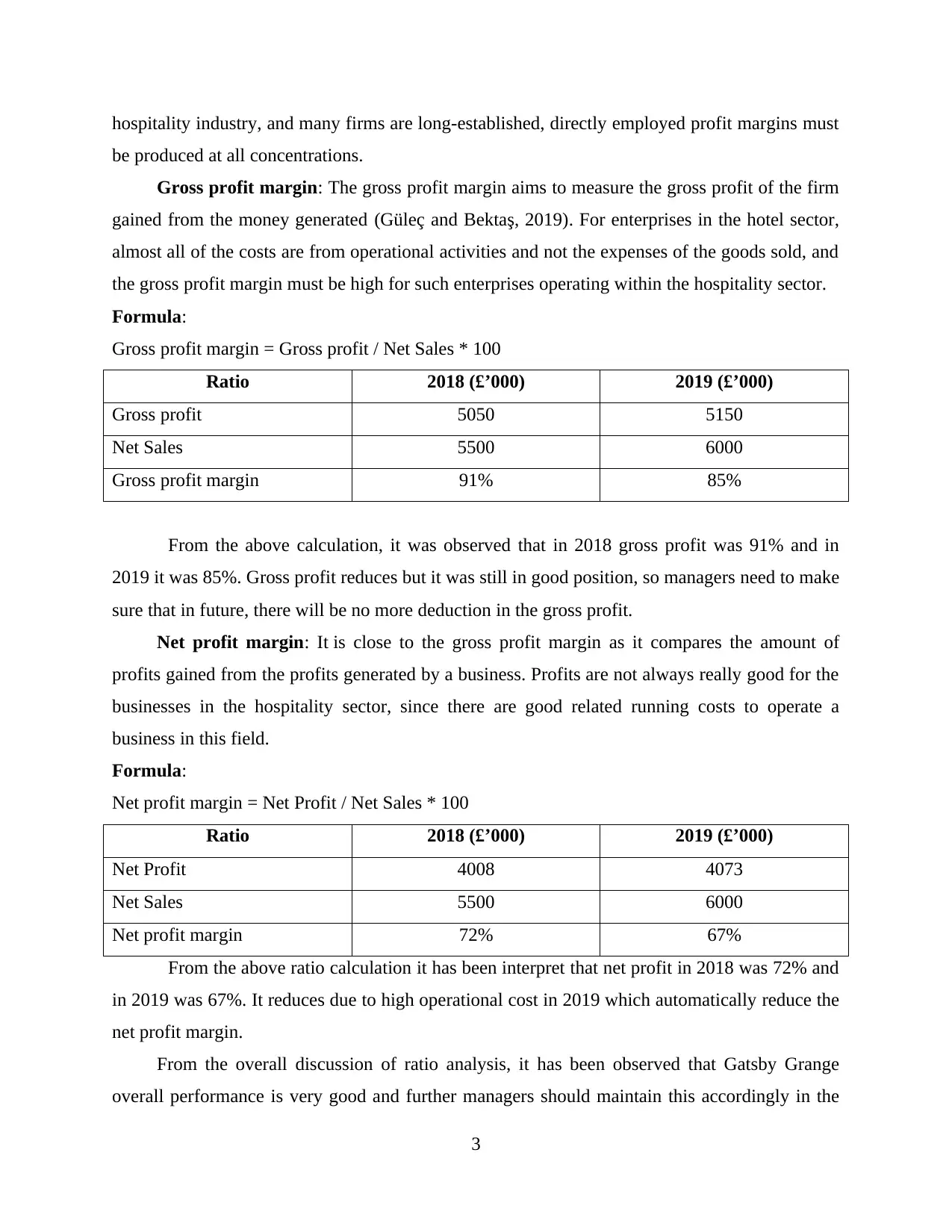
hospitality industry, and many firms are long-established, directly employed profit margins must
be produced at all concentrations.
Gross profit margin: The gross profit margin aims to measure the gross profit of the firm
gained from the money generated (Güleç and Bektaş, 2019). For enterprises in the hotel sector,
almost all of the costs are from operational activities and not the expenses of the goods sold, and
the gross profit margin must be high for such enterprises operating within the hospitality sector.
Formula:
Gross profit margin = Gross profit / Net Sales * 100
Ratio 2018 (£’000) 2019 (£’000)
Gross profit 5050 5150
Net Sales 5500 6000
Gross profit margin 91% 85%
From the above calculation, it was observed that in 2018 gross profit was 91% and in
2019 it was 85%. Gross profit reduces but it was still in good position, so managers need to make
sure that in future, there will be no more deduction in the gross profit.
Net profit margin: It is close to the gross profit margin as it compares the amount of
profits gained from the profits generated by a business. Profits are not always really good for the
businesses in the hospitality sector, since there are good related running costs to operate a
business in this field.
Formula:
Net profit margin = Net Profit / Net Sales * 100
Ratio 2018 (£’000) 2019 (£’000)
Net Profit 4008 4073
Net Sales 5500 6000
Net profit margin 72% 67%
From the above ratio calculation it has been interpret that net profit in 2018 was 72% and
in 2019 was 67%. It reduces due to high operational cost in 2019 which automatically reduce the
net profit margin.
From the overall discussion of ratio analysis, it has been observed that Gatsby Grange
overall performance is very good and further managers should maintain this accordingly in the
3
be produced at all concentrations.
Gross profit margin: The gross profit margin aims to measure the gross profit of the firm
gained from the money generated (Güleç and Bektaş, 2019). For enterprises in the hotel sector,
almost all of the costs are from operational activities and not the expenses of the goods sold, and
the gross profit margin must be high for such enterprises operating within the hospitality sector.
Formula:
Gross profit margin = Gross profit / Net Sales * 100
Ratio 2018 (£’000) 2019 (£’000)
Gross profit 5050 5150
Net Sales 5500 6000
Gross profit margin 91% 85%
From the above calculation, it was observed that in 2018 gross profit was 91% and in
2019 it was 85%. Gross profit reduces but it was still in good position, so managers need to make
sure that in future, there will be no more deduction in the gross profit.
Net profit margin: It is close to the gross profit margin as it compares the amount of
profits gained from the profits generated by a business. Profits are not always really good for the
businesses in the hospitality sector, since there are good related running costs to operate a
business in this field.
Formula:
Net profit margin = Net Profit / Net Sales * 100
Ratio 2018 (£’000) 2019 (£’000)
Net Profit 4008 4073
Net Sales 5500 6000
Net profit margin 72% 67%
From the above ratio calculation it has been interpret that net profit in 2018 was 72% and
in 2019 was 67%. It reduces due to high operational cost in 2019 which automatically reduce the
net profit margin.
From the overall discussion of ratio analysis, it has been observed that Gatsby Grange
overall performance is very good and further managers should maintain this accordingly in the
3
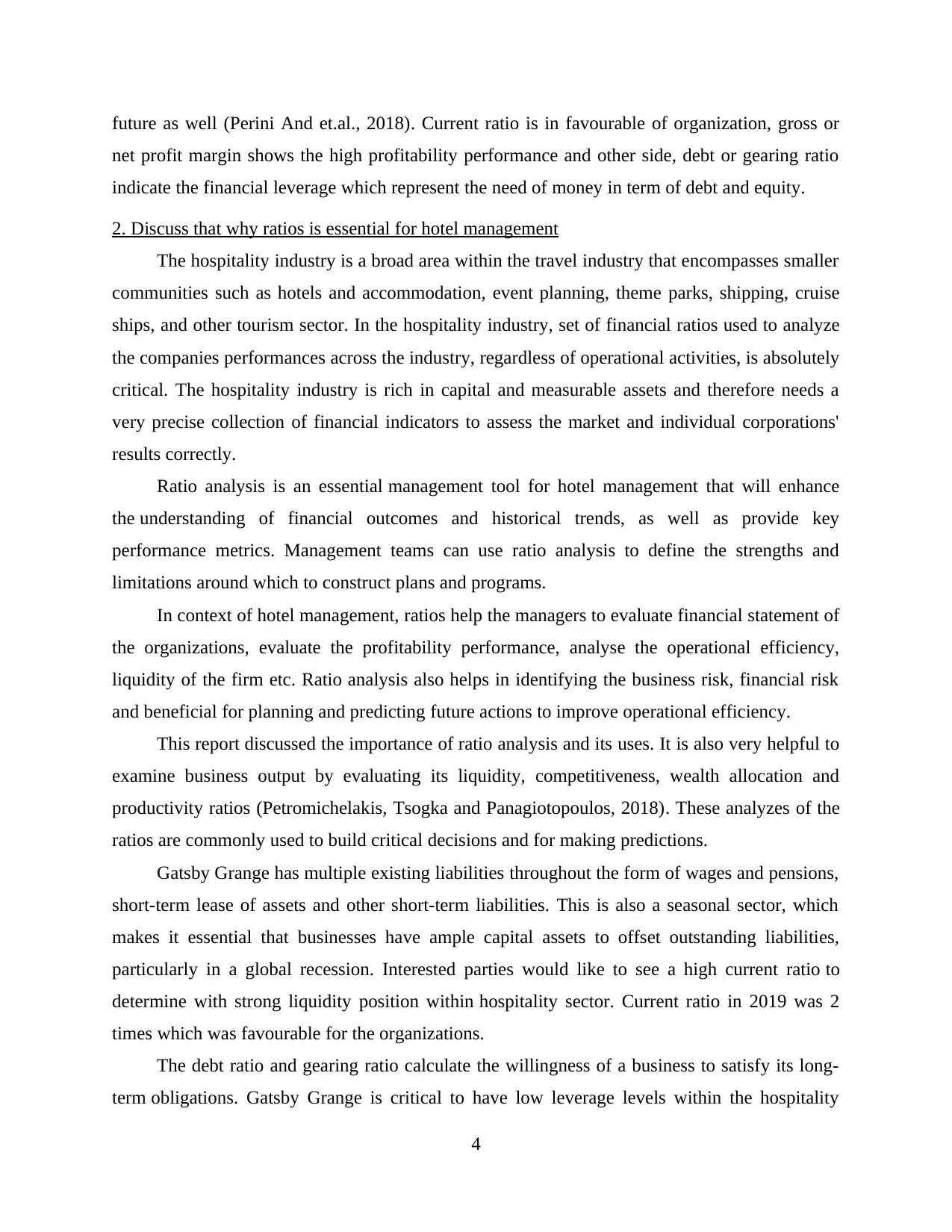
future as well (Perini And et.al., 2018). Current ratio is in favourable of organization, gross or
net profit margin shows the high profitability performance and other side, debt or gearing ratio
indicate the financial leverage which represent the need of money in term of debt and equity.
2. Discuss that why ratios is essential for hotel management
The hospitality industry is a broad area within the travel industry that encompasses smaller
communities such as hotels and accommodation, event planning, theme parks, shipping, cruise
ships, and other tourism sector. In the hospitality industry, set of financial ratios used to analyze
the companies performances across the industry, regardless of operational activities, is absolutely
critical. The hospitality industry is rich in capital and measurable assets and therefore needs a
very precise collection of financial indicators to assess the market and individual corporations'
results correctly.
Ratio analysis is an essential management tool for hotel management that will enhance
the understanding of financial outcomes and historical trends, as well as provide key
performance metrics. Management teams can use ratio analysis to define the strengths and
limitations around which to construct plans and programs.
In context of hotel management, ratios help the managers to evaluate financial statement of
the organizations, evaluate the profitability performance, analyse the operational efficiency,
liquidity of the firm etc. Ratio analysis also helps in identifying the business risk, financial risk
and beneficial for planning and predicting future actions to improve operational efficiency.
This report discussed the importance of ratio analysis and its uses. It is also very helpful to
examine business output by evaluating its liquidity, competitiveness, wealth allocation and
productivity ratios (Petromichelakis, Tsogka and Panagiotopoulos, 2018). These analyzes of the
ratios are commonly used to build critical decisions and for making predictions.
Gatsby Grange has multiple existing liabilities throughout the form of wages and pensions,
short-term lease of assets and other short-term liabilities. This is also a seasonal sector, which
makes it essential that businesses have ample capital assets to offset outstanding liabilities,
particularly in a global recession. Interested parties would like to see a high current ratio to
determine with strong liquidity position within hospitality sector. Current ratio in 2019 was 2
times which was favourable for the organizations.
The debt ratio and gearing ratio calculate the willingness of a business to satisfy its long-
term obligations. Gatsby Grange is critical to have low leverage levels within the hospitality
4
net profit margin shows the high profitability performance and other side, debt or gearing ratio
indicate the financial leverage which represent the need of money in term of debt and equity.
2. Discuss that why ratios is essential for hotel management
The hospitality industry is a broad area within the travel industry that encompasses smaller
communities such as hotels and accommodation, event planning, theme parks, shipping, cruise
ships, and other tourism sector. In the hospitality industry, set of financial ratios used to analyze
the companies performances across the industry, regardless of operational activities, is absolutely
critical. The hospitality industry is rich in capital and measurable assets and therefore needs a
very precise collection of financial indicators to assess the market and individual corporations'
results correctly.
Ratio analysis is an essential management tool for hotel management that will enhance
the understanding of financial outcomes and historical trends, as well as provide key
performance metrics. Management teams can use ratio analysis to define the strengths and
limitations around which to construct plans and programs.
In context of hotel management, ratios help the managers to evaluate financial statement of
the organizations, evaluate the profitability performance, analyse the operational efficiency,
liquidity of the firm etc. Ratio analysis also helps in identifying the business risk, financial risk
and beneficial for planning and predicting future actions to improve operational efficiency.
This report discussed the importance of ratio analysis and its uses. It is also very helpful to
examine business output by evaluating its liquidity, competitiveness, wealth allocation and
productivity ratios (Petromichelakis, Tsogka and Panagiotopoulos, 2018). These analyzes of the
ratios are commonly used to build critical decisions and for making predictions.
Gatsby Grange has multiple existing liabilities throughout the form of wages and pensions,
short-term lease of assets and other short-term liabilities. This is also a seasonal sector, which
makes it essential that businesses have ample capital assets to offset outstanding liabilities,
particularly in a global recession. Interested parties would like to see a high current ratio to
determine with strong liquidity position within hospitality sector. Current ratio in 2019 was 2
times which was favourable for the organizations.
The debt ratio and gearing ratio calculate the willingness of a business to satisfy its long-
term obligations. Gatsby Grange is critical to have low leverage levels within the hospitality
4
⊘ This is a preview!⊘
Do you want full access?
Subscribe today to unlock all pages.

Trusted by 1+ million students worldwide
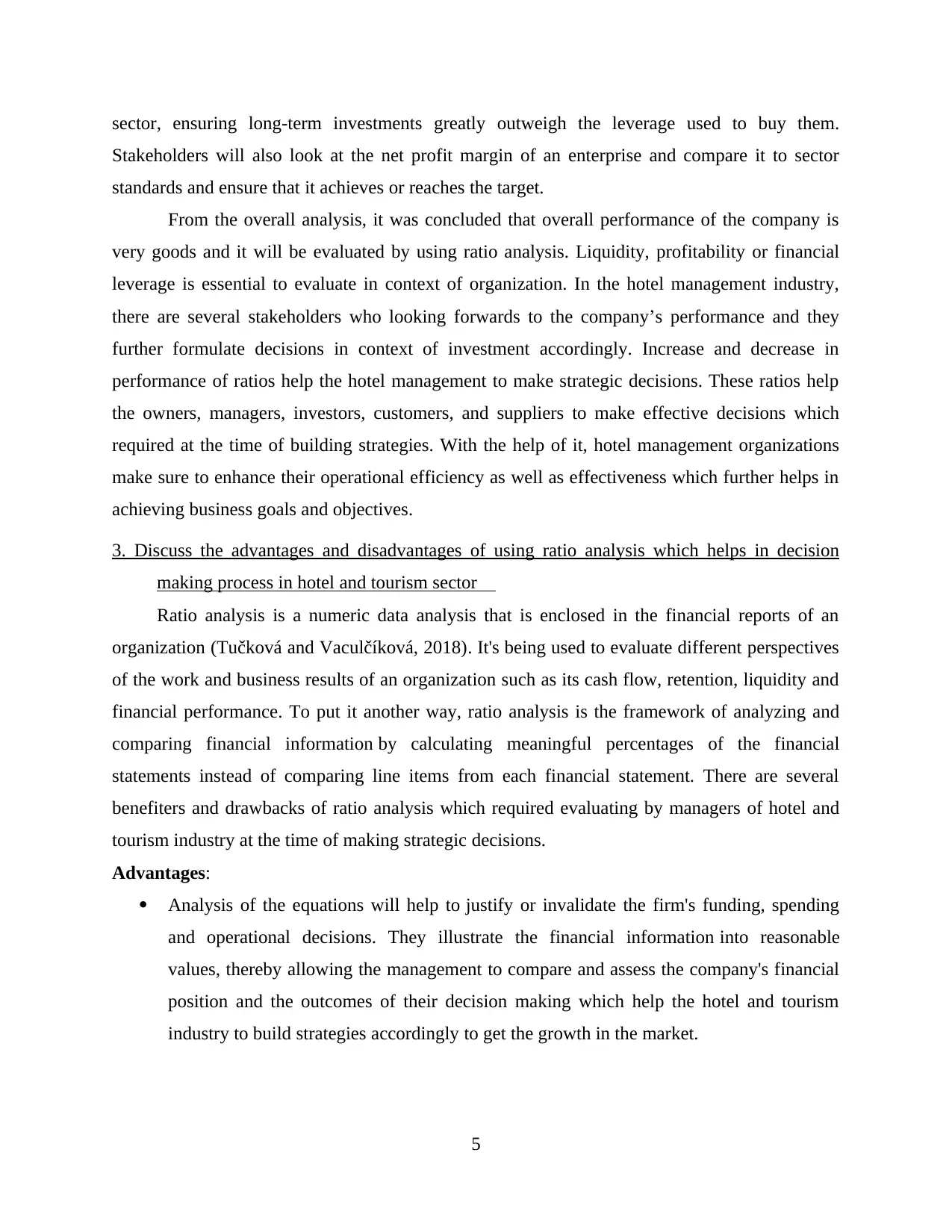
sector, ensuring long-term investments greatly outweigh the leverage used to buy them.
Stakeholders will also look at the net profit margin of an enterprise and compare it to sector
standards and ensure that it achieves or reaches the target.
From the overall analysis, it was concluded that overall performance of the company is
very goods and it will be evaluated by using ratio analysis. Liquidity, profitability or financial
leverage is essential to evaluate in context of organization. In the hotel management industry,
there are several stakeholders who looking forwards to the company’s performance and they
further formulate decisions in context of investment accordingly. Increase and decrease in
performance of ratios help the hotel management to make strategic decisions. These ratios help
the owners, managers, investors, customers, and suppliers to make effective decisions which
required at the time of building strategies. With the help of it, hotel management organizations
make sure to enhance their operational efficiency as well as effectiveness which further helps in
achieving business goals and objectives.
3. Discuss the advantages and disadvantages of using ratio analysis which helps in decision
making process in hotel and tourism sector
Ratio analysis is a numeric data analysis that is enclosed in the financial reports of an
organization (Tučková and Vaculčíková, 2018). It's being used to evaluate different perspectives
of the work and business results of an organization such as its cash flow, retention, liquidity and
financial performance. To put it another way, ratio analysis is the framework of analyzing and
comparing financial information by calculating meaningful percentages of the financial
statements instead of comparing line items from each financial statement. There are several
benefiters and drawbacks of ratio analysis which required evaluating by managers of hotel and
tourism industry at the time of making strategic decisions.
Advantages:
Analysis of the equations will help to justify or invalidate the firm's funding, spending
and operational decisions. They illustrate the financial information into reasonable
values, thereby allowing the management to compare and assess the company's financial
position and the outcomes of their decision making which help the hotel and tourism
industry to build strategies accordingly to get the growth in the market.
5
Stakeholders will also look at the net profit margin of an enterprise and compare it to sector
standards and ensure that it achieves or reaches the target.
From the overall analysis, it was concluded that overall performance of the company is
very goods and it will be evaluated by using ratio analysis. Liquidity, profitability or financial
leverage is essential to evaluate in context of organization. In the hotel management industry,
there are several stakeholders who looking forwards to the company’s performance and they
further formulate decisions in context of investment accordingly. Increase and decrease in
performance of ratios help the hotel management to make strategic decisions. These ratios help
the owners, managers, investors, customers, and suppliers to make effective decisions which
required at the time of building strategies. With the help of it, hotel management organizations
make sure to enhance their operational efficiency as well as effectiveness which further helps in
achieving business goals and objectives.
3. Discuss the advantages and disadvantages of using ratio analysis which helps in decision
making process in hotel and tourism sector
Ratio analysis is a numeric data analysis that is enclosed in the financial reports of an
organization (Tučková and Vaculčíková, 2018). It's being used to evaluate different perspectives
of the work and business results of an organization such as its cash flow, retention, liquidity and
financial performance. To put it another way, ratio analysis is the framework of analyzing and
comparing financial information by calculating meaningful percentages of the financial
statements instead of comparing line items from each financial statement. There are several
benefiters and drawbacks of ratio analysis which required evaluating by managers of hotel and
tourism industry at the time of making strategic decisions.
Advantages:
Analysis of the equations will help to justify or invalidate the firm's funding, spending
and operational decisions. They illustrate the financial information into reasonable
values, thereby allowing the management to compare and assess the company's financial
position and the outcomes of their decision making which help the hotel and tourism
industry to build strategies accordingly to get the growth in the market.
5
Paraphrase This Document
Need a fresh take? Get an instant paraphrase of this document with our AI Paraphraser
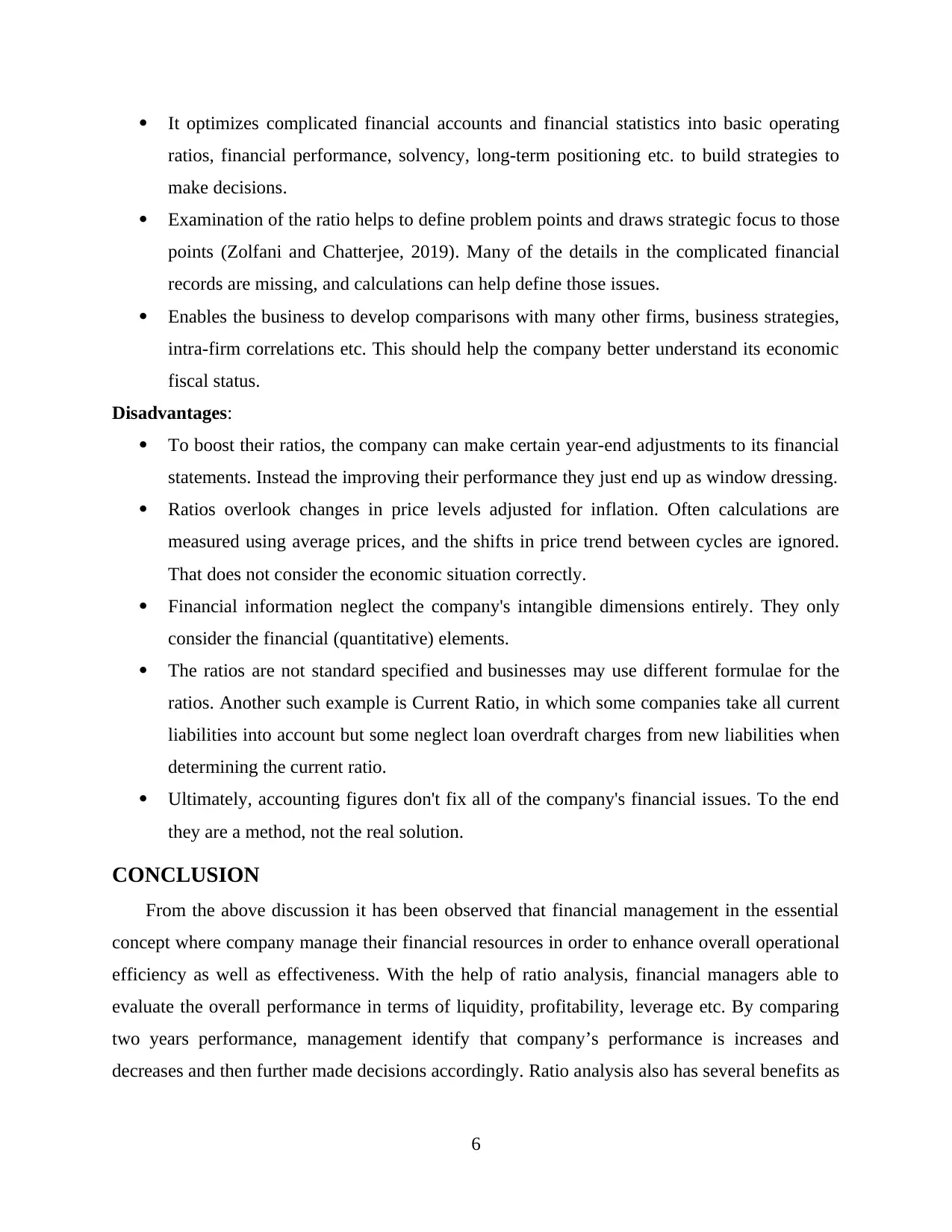
It optimizes complicated financial accounts and financial statistics into basic operating
ratios, financial performance, solvency, long-term positioning etc. to build strategies to
make decisions.
Examination of the ratio helps to define problem points and draws strategic focus to those
points (Zolfani and Chatterjee, 2019). Many of the details in the complicated financial
records are missing, and calculations can help define those issues.
Enables the business to develop comparisons with many other firms, business strategies,
intra-firm correlations etc. This should help the company better understand its economic
fiscal status.
Disadvantages:
To boost their ratios, the company can make certain year-end adjustments to its financial
statements. Instead the improving their performance they just end up as window dressing.
Ratios overlook changes in price levels adjusted for inflation. Often calculations are
measured using average prices, and the shifts in price trend between cycles are ignored.
That does not consider the economic situation correctly.
Financial information neglect the company's intangible dimensions entirely. They only
consider the financial (quantitative) elements.
The ratios are not standard specified and businesses may use different formulae for the
ratios. Another such example is Current Ratio, in which some companies take all current
liabilities into account but some neglect loan overdraft charges from new liabilities when
determining the current ratio.
Ultimately, accounting figures don't fix all of the company's financial issues. To the end
they are a method, not the real solution.
CONCLUSION
From the above discussion it has been observed that financial management in the essential
concept where company manage their financial resources in order to enhance overall operational
efficiency as well as effectiveness. With the help of ratio analysis, financial managers able to
evaluate the overall performance in terms of liquidity, profitability, leverage etc. By comparing
two years performance, management identify that company’s performance is increases and
decreases and then further made decisions accordingly. Ratio analysis also has several benefits as
6
ratios, financial performance, solvency, long-term positioning etc. to build strategies to
make decisions.
Examination of the ratio helps to define problem points and draws strategic focus to those
points (Zolfani and Chatterjee, 2019). Many of the details in the complicated financial
records are missing, and calculations can help define those issues.
Enables the business to develop comparisons with many other firms, business strategies,
intra-firm correlations etc. This should help the company better understand its economic
fiscal status.
Disadvantages:
To boost their ratios, the company can make certain year-end adjustments to its financial
statements. Instead the improving their performance they just end up as window dressing.
Ratios overlook changes in price levels adjusted for inflation. Often calculations are
measured using average prices, and the shifts in price trend between cycles are ignored.
That does not consider the economic situation correctly.
Financial information neglect the company's intangible dimensions entirely. They only
consider the financial (quantitative) elements.
The ratios are not standard specified and businesses may use different formulae for the
ratios. Another such example is Current Ratio, in which some companies take all current
liabilities into account but some neglect loan overdraft charges from new liabilities when
determining the current ratio.
Ultimately, accounting figures don't fix all of the company's financial issues. To the end
they are a method, not the real solution.
CONCLUSION
From the above discussion it has been observed that financial management in the essential
concept where company manage their financial resources in order to enhance overall operational
efficiency as well as effectiveness. With the help of ratio analysis, financial managers able to
evaluate the overall performance in terms of liquidity, profitability, leverage etc. By comparing
two years performance, management identify that company’s performance is increases and
decreases and then further made decisions accordingly. Ratio analysis also has several benefits as
6
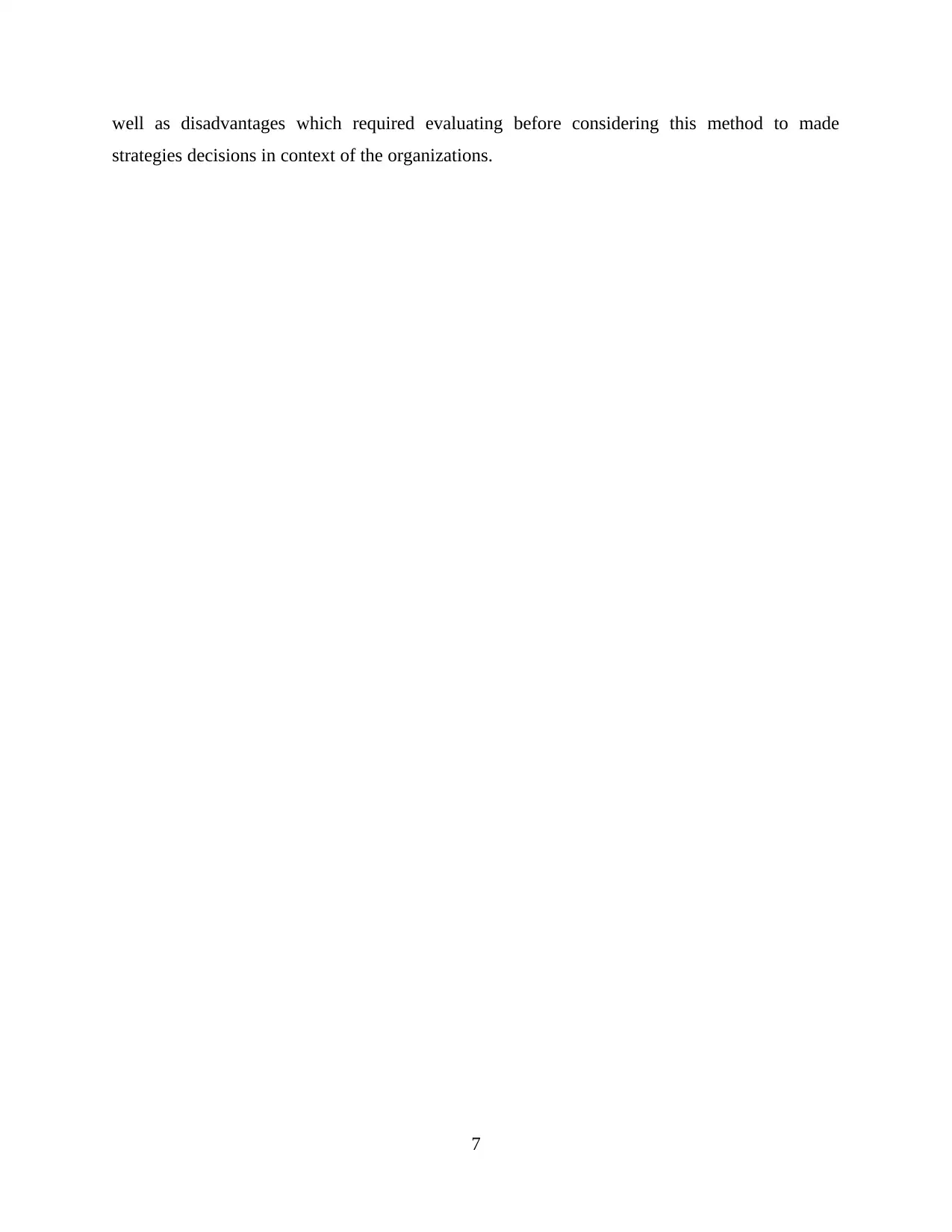
well as disadvantages which required evaluating before considering this method to made
strategies decisions in context of the organizations.
7
strategies decisions in context of the organizations.
7
⊘ This is a preview!⊘
Do you want full access?
Subscribe today to unlock all pages.

Trusted by 1+ million students worldwide

REFERENCES
Books & Journals
Forbes, T. P. and Szakal, C., 2019. Considerations for uranium isotope ratio analysis by
atmospheric pressure ionization mass spectrometry. Analyst. 144(1). pp.317-323.
Güleç, Ö. F. and Bektaş, T., 2019. Cash Flow Ratio Analysis: The Case Of Turkey.
Khodadoust, A. M. and Hodtani, G. A., 2019. Carrier to interference ratio analysis in shotgun
cellular systems over a generalized shadowing distribution. Wireless Networks. 25(8).
pp.4447-4457.
Kim, D. and Im, M., 2018. What makes red quasars red?-Observational evidence for dust
extinction from line ratio analysis. Astronomy & Astrophysics. 610. p.A31.
Perini, M. And et.al., 2018. Stable isotope ratio analysis of different European raspberries,
blackberries, blueberries, currants and strawberries. Food Chemistry, 239, pp.48-55.
Petromichelakis, I., Tsogka, C. and Panagiotopoulos, C. G., 2018. Signal-to-Noise Ratio analysis
for time-reversal based imaging techniques in bounded domains. Wave Motion. 79.
pp.23-43.
Tučková, Z. and Vaculčíková, Z., 2018. INNOVATION OF ECONOMIC SUSTAINABILITY
AND ITS MEASUREMENT IN HOTEL INDUSTRY.
Zolfani, S. H. and Chatterjee, P., 2019. Comparative evaluation of sustainable design based on
Step-Wise Weight Assessment Ratio Analysis (SWARA) and Best Worst Method
(BWM) methods: a perspective on household furnishing materials. Symmetry. 11(1).
p.74.
8
Books & Journals
Forbes, T. P. and Szakal, C., 2019. Considerations for uranium isotope ratio analysis by
atmospheric pressure ionization mass spectrometry. Analyst. 144(1). pp.317-323.
Güleç, Ö. F. and Bektaş, T., 2019. Cash Flow Ratio Analysis: The Case Of Turkey.
Khodadoust, A. M. and Hodtani, G. A., 2019. Carrier to interference ratio analysis in shotgun
cellular systems over a generalized shadowing distribution. Wireless Networks. 25(8).
pp.4447-4457.
Kim, D. and Im, M., 2018. What makes red quasars red?-Observational evidence for dust
extinction from line ratio analysis. Astronomy & Astrophysics. 610. p.A31.
Perini, M. And et.al., 2018. Stable isotope ratio analysis of different European raspberries,
blackberries, blueberries, currants and strawberries. Food Chemistry, 239, pp.48-55.
Petromichelakis, I., Tsogka, C. and Panagiotopoulos, C. G., 2018. Signal-to-Noise Ratio analysis
for time-reversal based imaging techniques in bounded domains. Wave Motion. 79.
pp.23-43.
Tučková, Z. and Vaculčíková, Z., 2018. INNOVATION OF ECONOMIC SUSTAINABILITY
AND ITS MEASUREMENT IN HOTEL INDUSTRY.
Zolfani, S. H. and Chatterjee, P., 2019. Comparative evaluation of sustainable design based on
Step-Wise Weight Assessment Ratio Analysis (SWARA) and Best Worst Method
(BWM) methods: a perspective on household furnishing materials. Symmetry. 11(1).
p.74.
8
1 out of 10
Related Documents
Your All-in-One AI-Powered Toolkit for Academic Success.
+13062052269
info@desklib.com
Available 24*7 on WhatsApp / Email
![[object Object]](/_next/static/media/star-bottom.7253800d.svg)
Unlock your academic potential
© 2024 | Zucol Services PVT LTD | All rights reserved.





